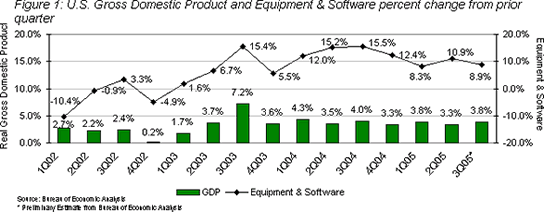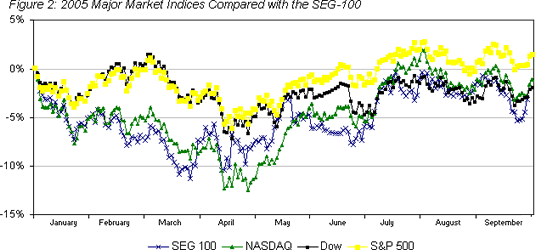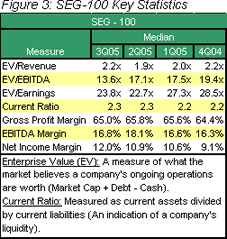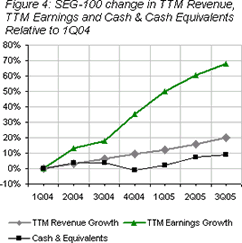|
|
| Home - Software M&A Review - Nov 05 Issue |
Software M&A - Robust Q3 Deals Despite Katrina |
By Ken Bender and Allen Cinzori, Software Equity Group, LLC
Economy
Despite soaring crude oil prices, Katrina and inflation concerns, the U.S. economy continued to improve in the third quarter of 2005. Gross Domestic Product (GDP), a key economic indicator and broadest measure of economic activity, is projected to grow at an annualized rate of 3.8% in 3Q05. Second quarter GDP was revised to 3.3% (Figure 1). According to a midyear survey of 56 forecasters by The Wall Street Journal, economists are cautiously projecting 3.2% GDP growth in 4Q05. Personal consumption, exports, private investment, and equipment and software expenditures are likely to be the key drivers. According to the U.S. Department of Commerce, equipment and software spending, a component of GDP that is primarily IT related, was a major contributor to the GDP growth in 3Q05. Equipment and software spending increased 8.9% in 3Q05 over 2Q05, and 10.9% in 2Q05 over the prior quarter.

The Conference Board's index of leading economic indicators, which gauges the economy's likely performance over the next three to six months, paints a less optimistic picture. The growth rate of the leading index has been slowing steadily from a peak of approximately 10% in 2003, and has been fluctuating in the 0.5% to 1.5% range in recent months. Only four in ten indicators that comprise the leading index increased in September. The positive contributors - beginning with the most positive contributor - were vendor performance, building permits, interest rate spread and stock price. The negative contributors - beginning with the most negative - were average weekly initial claims for unemployment insurance (inverted), index of consumer expectations, real money supply, manufacturers" new orders for nondefense capital goods, and manufacturers" new orders for consumer goods and materials. The leading index has been fluctuating around a relatively flat trend throughout 2005.
Committed to keeping inflation at bay, the Federal Reserve stayed the course and raised the Federal Funds rate 25 basis points to 3.75% at the end of 3Q05. The Fed has raised its benchmark interest rate 11 times since June 2004 and many economists expect it to raise rates twice more this year, to 4.25%.
Both the number of unemployed, 7.7 million, and the unemployment rate, 5.1%, rose in September. Both had been declining in recent months, but are still lower than a year ago. The September unemployment rate is up from 4.9% in August, but is considerably lower than the 5.4% rate posted in September 2004. Wall Street Journal economists anticipate a 5% unemployment rate in November of this year, and a 4.9% rate in May of 2006.

 Public Market and Public Software Company Performance Public Market and Public Software Company Performance
Public markets continued to reflect investor uneasiness in the third quarter of 2005. The three principal market indices (Dow, NASDAQ and S&P 500) posted quarter-over-prior quarter gains of 2.9%, 4.6% and 3.2%, respectively. For the year, U.S. public markets are hovering at break even, with the Dow and NASDAQ posting declines of 2.0% and 1.1% respectively, and the S&P 500 up 1.4% since January 1 (Figure 2). Market caps of the SEG-100, our index of public software companies, showed signs of strength during much of the third quarter, but retreated at the quarter's end, posting a modest 4.5% improvement over the close of Q2, but down 3.2% from January 1. Other key 3Q05 measures for the SEG-100, including comparisons with the prior quarter, are enumerated in Figure 3.
 On a trailing-twelve-month (TTM) revenue basis, overall financial performance of the SEG-100 continued to improve. Median TTM revenue is up 20.1% from our 1Q04 base period, while TTM earnings relative to the same base period has skyrocketed to 67.6%. SEG-100 cash and cash equivalents also increased over the same time period, an obvious by-product of an improving bottom line (Figure 4). Since 2002, public software companies have been focusing resolutely on cost cutting and earnings improvement as a means of retaining investor confidence despite stagnant revenue growth. Having done so, most public software companies have shifted focus, seeking top line growth both organically and through mergers and acquisitions. 3Q05 deals, which are representative of an M&A driven revenue enhancement strategy, include SSA Global/E.piphany, Oracle/Siebel, GE/IDX Systems, Secure Computing/CyberGuard, BEA/Plumtree 3Q05 transactions. On a trailing-twelve-month (TTM) revenue basis, overall financial performance of the SEG-100 continued to improve. Median TTM revenue is up 20.1% from our 1Q04 base period, while TTM earnings relative to the same base period has skyrocketed to 67.6%. SEG-100 cash and cash equivalents also increased over the same time period, an obvious by-product of an improving bottom line (Figure 4). Since 2002, public software companies have been focusing resolutely on cost cutting and earnings improvement as a means of retaining investor confidence despite stagnant revenue growth. Having done so, most public software companies have shifted focus, seeking top line growth both organically and through mergers and acquisitions. 3Q05 deals, which are representative of an M&A driven revenue enhancement strategy, include SSA Global/E.piphany, Oracle/Siebel, GE/IDX Systems, Secure Computing/CyberGuard, BEA/Plumtree 3Q05 transactions.
|
|


|

